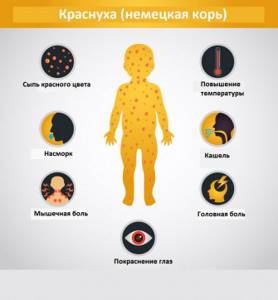Rubella (German measles, Rubella, Measles)
Arthritis
Encephalitis
15869 November 19
IMPORTANT!
The information in this section cannot be used for self-diagnosis and self-treatment.
In case of pain or other exacerbation of the disease, diagnostic tests should be prescribed only by the attending physician. To make a diagnosis and properly prescribe treatment, you should contact your doctor. Rubella: causes, symptoms, diagnosis and treatment methods.
Definition
Rubella is an acute infectious disease transmitted by airborne droplets. The site of entry (entry gate) of the rubella virus (Rubella virus) is the mucous membrane of the upper respiratory tract. Humans are the only known carrier of this virus.
In children, the disease is usually mild, with symptoms including rash, fever (<39°C), vomiting and mild conjunctivitis. The rash, which appears in 50-80% of cases, usually first appears on the face and neck, then moves down the body and lasts 1-3 days. Swollen lymph nodes behind the ears and neck are the most common clinical sign. Infected adults, most often women, may develop arthritis with joint pain that usually lasts 3-10 days.
Causes of rubella
The source of infection can be patients in whom rubella occurs in an acute form, as well as those in whom the disease occurs in an erased and atypical form. In 30-50% of infected children, rubella is asymptomatic. Susceptibility to rubella is universal, but is considered highest in children aged 3 to 4 years. Single contact with a patient is not enough for the disease to occur; prolonged and close contact leads to infection. The infection is not transmitted through objects and third parties due to the low stability of the virus in the external environment.
Classification of the disease
Coding according to ICD-10
B 06. Rubella (German measles).
At 06.0. Rubella with neurological complications:
- encephalitis (G05.1),
- meningitis (G02.0),
- meningoencephalitis (G05.1).
At 06.8. Rubella with other complications:
- arthritis (M01.4),
- pneumonia (J17.1).
At 06.9.
Rubella without complications Clinical classification of rubella:
Type
:
- typical;
- atypical:
- with isolated exanthema syndrome,
- with isolated lymphadenopathy syndrome,
- erased,
- asymptomatic.
By severity:
- mild severity,
- moderate severity,
- heavy.
With the flow:
- smooth;
- unsmooth:
- with complications
- with a layer of secondary infection,
- with exacerbation of chronic diseases.
Symptoms of rubella Intoxication syndrome
: malaise, slight weakness, moderate headache, sometimes pain in muscles and joints. The temperature is subfebrile or normal, sometimes rises to febrile levels, lasts 1-3 days.
Respiratory tract syndrome (catarrhal syndrome)
poorly expressed. There is slight hyperemia of the pharynx, conjunctivitis, and a rash in the form of small pale pink spots on the soft palate (Forchheimer spots). Sometimes there is hyperemia, granularity of the oral mucosa, and pinpoint hemorrhages on the uvula and soft palate. Rhinitis and dry cough are usually observed in older children.

Lymphadenopathy syndrome
develops 1-3 days before the appearance of the rash and catarrhal symptoms and disappears a few days after the rash subsides. It is characterized by enlargement and tenderness of the occipital and posterior cervical lymph nodes, and generalized lymphadenopathy is possible.
Exanthema syndrome
is one of the permanent signs of rubella. The rash first appears on the face, behind the ears, on the scalp, and within 24 hours spreads from the face to the torso and limbs. Due to the rapid spread of exanthema, the rash appears to occur all at once. The rash is more pronounced on the extensor surfaces of the extremities, on the back, lower back, and buttocks. In 75% of patients, the rash is small-spotted (diameter 5-7 mm), in some cases (in 5% of patients) it can be large-spotted (diameter 10 mm or more), less often - maculopapular. There is no exanthema on the palms and soles.
Diagnosis of rubella
Diagnosis of rubella is made by collecting anamnesis, clinical examination, laboratory and special examination methods and is aimed at determining the nosology and clinical form, severity of the condition, identifying complications and indications for treatment.
A clinical blood test in the acute period of the disease must be performed in all patients to determine the level of leukocytes, the number of plasma cells, platelets, and ESR.
Detailed description of the study
Rubella is an acute infectious disease caused by the rubella virus. Children aged 2-9 years are most often affected. The virus is excreted in nasopharyngeal secretions, urine and feces.
Infection occurs by airborne droplets. The source of infection is a sick person who is contagious from the moment signs of the disease appear and for 5 days from the onset of the rash. The rubella virus is transmitted from mother to fetus through the placenta. The causative agent of rubella penetrates the mucous membranes of the upper respiratory tract and multiplies in the cervical lymph nodes, from where it enters the blood and affects the lymphoid tissue.
The incubation period is 15-24 days. In children, the disease occurs against a background of low-grade body temperature and is characterized by the appearance of a pink, small-spotted rash on the skin of the face, torso and limbs. After 2-3 days the rash disappears. In adults, the disease is more severe: intoxication is observed, enlargement of lymph nodes and a rise in body temperature are more pronounced. Rubella disease in the first 3 months of pregnancy leads to transplacental infection of the fetus and malformations (cataracts, microcephaly, heart defects, etc.). Stillbirth is often observed, so the disease in women during this period is an indication for termination of pregnancy. The disease in the last 3 months of pregnancy can lead to the development of clinical manifestations of the disease in the newborn (congenital rubella).
Positive IgM to rubella is detected on the 3-4th day after the onset of clinical signs of the disease and reaches its maximum value after 7-10 days. The disappearance of IgM is recorded 4-5 weeks from the onset of the disease. IgM are not produced during rubella reactivation or reinfection; the presence of these forms of the disease can only be indicated by an increase in the concentration of specific IgG when examining paired serum samples.
Primary infection with rubella is especially dangerous for pregnant women in the first trimester of pregnancy. The virus penetrates the placenta and infects embryonic tissue. Congenital rubella syndrome (CRS) includes heart pathology, eye damage, hearing loss, developmental delay, and neurological disorders. The only method of preventing the development of rubella in women of childbearing age and preventing CRS is vaccination before conception (at least 3 months before).
Rubella virus, IgG antibodies (Anti-Rubella IgG), determination of avidity index
Rubella is an acute infectious anthroponotic disease caused by an RNA-containing virus that belongs to the togaviruses (family Togaviridae, genus Rubivirus). Infection occurs by airborne droplets. The rubella virus is released into the external environment a week before the rash appears and for a week after the rash. The incubation period lasts 2-3 weeks. In 30-50% of infected people, rubella is asymptomatic. In cases where symptoms are present, the clinical picture includes fever, papular rash with a short period of eruption, lymphadenopathy, runny nose, and conjunctivitis. Adenopathy in rubella is a constant sign of the disease, often being the only manifestation. Rubella is especially dangerous for pregnant women due to intrauterine infection of the fetus. The frequency of fetal lesions depends on the gestational period. The earlier the mother is infected, the higher the likelihood of damage to the fetus and the wider the range of possible developmental abnormalities. Rubella disease in the first trimester of pregnancy is the most dangerous and causes congenital deformities in the unborn child in 60% of cases. These are developmental delays, visual and hearing damage, congenital heart defects, damage to the bones of the extremities, skull, etc. Therefore, it is recommended to conduct a systematic serological analysis in women of reproductive age to identify a risk group (with the absence of antibodies to the rubella virus). Laboratory diagnosis of rubella is based on the identification of serological markers (immunoglobulins IgM, IgG and IgG avidity). Specific IgG antibodies usually appear approximately 1 week after the formation of IgM antibodies; their level increases rapidly, reaching a maximum at 6-10 weeks from the onset of the disease, and then gradually decreases to a certain titer and can persist throughout life. Reinfection, which occurs completely without symptoms, is accompanied by a moderate increase in IgG. Determination of IgG class antibodies is used in assessing post-vaccination immunity (appears on the 25-50th day after vaccination) and determining a history of infection. What is the research used for? To test immunity to the rubella virus; to detect infections, including those suffered in the past; to ensure that pregnant women (or those who are just planning a pregnancy) have sufficient anti-rubella antibodies to protect against infection; for differential diagnosis with contact dermatitis, erythema multiforme, measles, skin manifestations of syphilis, scarlet fever, Kawasaki disease. When is the study scheduled? Examination of pregnant women in case of detection of positive and questionable results of determination of IgM antibodies (if IgG results are positive); assessment of the duration of infection with the rubella virus; assessment of immunity before/after vaccination; if the patient has a low fever, headache, rhinorrhea, conjunctivitis, or decreased appetite; in a set of serological tests for the diagnosis of rubella.


